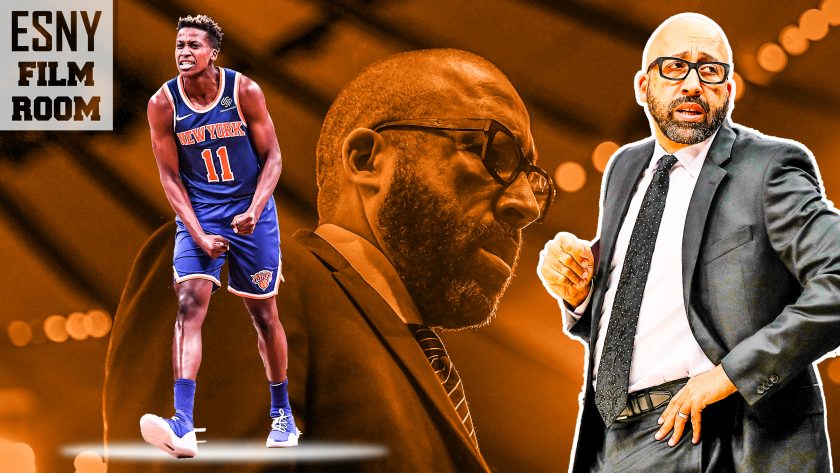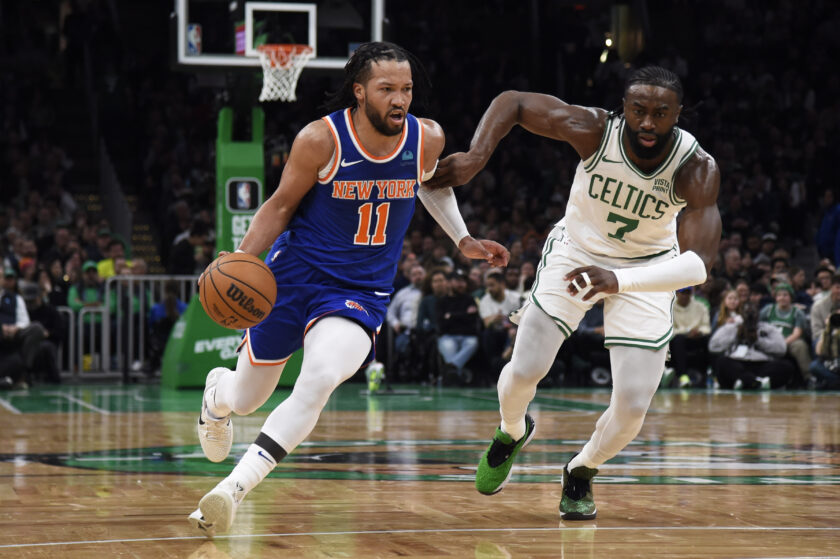New York Knicks: David Fizdale’s zone defense is making an impact (Film Room)

The New York Knicks and David Fizdale are throwing zone defenses at their opponents lately. Here’s why it’s more important than you think.
[sc name=”Small Film Room”]The New York Knicks are bad defensively. There is no sugarcoating it. If their ugly 128-110 loss to the Phoenix Suns wasn’t proof enough, they currently rank 29th in the league in defensive rating per NBA.com.
The general ineptitude on defense is forcing head coach David Fizdale to stay creative. He’s been forced to tinker with matchups, use different types of coverages on the pick-and-roll, but most recently, he’s started employing more zone defense.
Zone defense isn’t commonplace in the NBA. It’s more prevalent in youth basketball, college games, and probably your local slow-break league. But it’s not a type of defense featured heavily in the NBA. Zone defense is more like the “kitchen sink.” If nothing else is working, throw out a zone defense (hence the proverbial kitchen sink).
Fizdale has thrown out zone defenses a few times this year, most effectively in a recent comeback victory against the Charlotte Hornets. The zone completely threw off Kemba Walker and the Hornets, allowing the Knicks to complete an improbable comeback victory on the road with the likes of Luke Kornet and Emmanuel Mudiay leading the way.
“It’s been something that’s kind of working for us,” Fizdale told reporters following Sunday’s loss to the Indiana Pacers. “I think it’s familiar to this group because half of them were just playing a lot of zone about a year ago. I just kinda caved in a little bit and said let’s try something that’s a little more in their comfort zone. The mixing up of the zone has definitely helped them find some comfort.”
The Knicks are among a few teams this season who are finding success with zone defense. Coincidentally or not, Fiz’s close friend Erik Spoelstra is also using zone with his Miami Heat. It’s something both coaches are turning to when they need to wake up lackluster defenses. But it isn’t something teams can use as their main defense because teams will eventually become wise to it.
[sc name=”Knicks Center”] [sc name=”Knicks Title” text=”Second Half Success In Charlotte” ]“For sure. Once you get to see it on film, you’re gonna get prepared for it,” Fizdale admitted to reporters following Sunday’s loss. “But I can’t even think about it in those terms. I’m just looking at it to where I’m just trying to give us a chance to stop people and I think mixing it up kind of helps us.”
Fizdale made the call to switch to zone in the second half. One of the main reasons for the move was the Hornets’ success from beyond the arc. Charlotte shot 12-for-20 from three-point range in the first half, helping them jump out to a 72-53 lead.
The Knicks employed a 2-3 zone (or 2-1-2 zone if you’re one of those people), which is usually not the best strategy to stop three-point shooters. So why would Fizdale make the switch to 2-3 if the Hornets were killing it from beyond the arc?
Their first-half barrage of three-pointers was the result of awful pick-and-roll defense. The Knicks, and more specifically Enes Kanter, had no answer for Kemba Walker, Jeremy Lamb, and Tony Parker knifing through the lane and the penetration allowed for easy kick out passes to shooters.
The sequence of plays below shows a few times in the first half when the Hornets burned the Knicks on a pick-and-roll set that ended with a kick out three-pointer. (Shout out to our Spanish-speaking readers.)
https://vimeo.com/306966452
When the Knicks made the switch in the second half, Charlotte wasn’t finding it as easy to penetrate into the heart of the defense. Moreover, when they were allowing penetration, the Knicks were in much better position to recover out to shooters.
Could the Hornets have done a better job spacing the floor? Probably, but the change in defensive energy was palpable after the Knicks made the switch to zone. The play below shows a willingness to recover from Tim Hardaway Jr. and he’s in position to close out on two Hornets. The Knicks did allow an offensive rebound—which is a huge reason we don’t use zone more often.
But the Knicks were willing to sacrifice a little muscle on the glass if it meant they could shake Charlotte from its first-half rhythm. That’s exactly what the zone did. It took away some of the Hornets pick-and-roll game. Furthermore, the Knicks were much more cognizant about closing out on shooters.
Not only that, but the Hornets began settling for tough looks. Jeremy Lamb settled for a few long, contested threes and Walker, although he’s good at making tough shots, settled for a few low-percentage looks.
https://vimeo.com/306970530
The zone defense played a pivotal part in the comeback. But the offense put a lot of pressure on Charlotte as well. Either way, the switch to zone definitely took Charlotte out of their rhythm and played a crucial role in the comeback.
That being said, too much zone defense burns every team eventually.
[sc name=”Knicks Title” text=”Playing With Fire” ]In the NBA, there are too many bona fide scorers to play zone consistently. Eventually, coaches will adjust to the zone and shooters will start knocking down threes. It’s not a matter of “if” teams will figure out the zone, it’s “when.”
That’s why Fizdale was quick to go away from zone when the Pacers started to figure it out on Sunday. After a few three-pointers and a couple high-low dumps into the post, coaches usually know it’s time to go back to man-to-man defense.
https://vimeo.com/306973922
It worked for a bit in the first half, but it became clear that the Pacers were comfortable attacking the zone. Knowing when to switch out of the zone isn’t always easy, but sometimes it’s unmistakable. On Sunday, Fizdale went away from it before it was too late.
[sc name=”Knicks Title” text=”In Closing” ]So what does the Knicks’ recent foray into zone defense tell us? Well, for starters it shows Fizdale’s willingness to adapt to his personnel and think outside the box. It’s hard to understate how crucial the switch to zone was against Charlotte. It was a driving force in the Knicks’ comeback and that kind of in-game adjustment bodes well for Fizdale’s future.
It’s not going to work for extended periods of time. But it can be a useful strategy to give his defense a spark and throw opposing offenses off their game.
After all, Fizdale was an assistant coach for the Miami Heat in the 2011 NBA Finals. The Dallas Mavericks’ use of zone was instrumental in the team’s upset over LeBron James and company. I would venture to guess that Fizdale still has vivid memories of that series.
The zone may not help the Knicks climb out of their defensive rut this season. But it’s another reason to believe the Knicks have the right guy leading the team.
[sc name=”Knicks Link Next” link=”https://elitesportsny.com/2018/12/14/new-york-knicks-kevin-knoxs-offense-broken-down-into-3-shots/” text=”Breaking Down Kevin Knox’s Offense Into 3 Key Shots (FILM ROOM)” ] [sc name=”Knicks Footer”]




